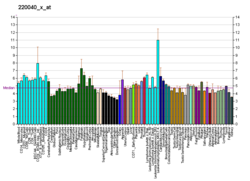| ZC4H2 |
|---|
|
| Identifiers |
|---|
| Aliases | ZC4H2, HCA127, KIAA1166, WRWF, WWS, zinc finger C4H2-type containing, MRXS4, MCS, WRWFFR |
|---|
| External IDs | OMIM: 300897; MGI: 2679294; HomoloGene: 10266; GeneCards: ZC4H2; OMA:ZC4H2 - orthologs |
|---|
| Gene location (Human) |
|---|
 | | Chr. | X chromosome (human)[1] |
|---|
| | Band | Xq11.2 | Start | 64,915,802 bp[1] |
|---|
| End | 65,034,713 bp[1] |
|---|
|
| Gene location (Mouse) |
|---|
 | | Chr. | X chromosome (mouse)[2] |
|---|
| | Band | X|X C3 | Start | 94,682,799 bp[2] |
|---|
| End | 94,702,115 bp[2] |
|---|
|
| RNA expression pattern |
|---|
| Bgee | | Human | Mouse (ortholog) |
|---|
| Top expressed in | - ganglionic eminence
- ventricular zone
- prefrontal cortex
- muscle layer of sigmoid colon
- popliteal artery
- tibial arteries
- stromal cell of endometrium
- C1 segment
- Descending thoracic aorta
- islet of Langerhans
|
| | Top expressed in | - superior cervical ganglion
- medial ganglionic eminence
- hand
- genital tubercle
- trigeminal ganglion
- tail of embryo
- otolith organ
- ventricular zone
- utricle
- primitive streak
|
| | More reference expression data |
|
|---|
| BioGPS |  | | More reference expression data |
|
|---|
|
| Gene ontology |
|---|
| Molecular function | - protein binding
- metal ion binding
| | Cellular component | - cytoplasm
- cell junction
- postsynaptic membrane
- plasma membrane
- synapse
- nucleus
- membrane
| | Biological process | - multicellular organism development
- spinal cord motor neuron differentiation
- neuromuscular junction development
- nervous system development
- positive regulation of neuron differentiation
- cell differentiation
| | Sources:Amigo / QuickGO |
|
| Orthologs |
|---|
| Species | Human | Mouse |
|---|
| Entrez | | |
|---|
| Ensembl | | |
|---|
| UniProt | | |
|---|
| RefSeq (mRNA) | |
|---|
NM_001178032
NM_001178033
NM_001243804
NM_018684 |
| |
|---|
NM_001003916
NM_001289696
NM_001289697 |
|
|---|
| RefSeq (protein) | |
|---|
NP_001171503
NP_001171504
NP_001230733
NP_061154 |
| |
|---|
NP_001003916
NP_001276625
NP_001276626 |
|
|---|
| Location (UCSC) | Chr X: 64.92 – 65.03 Mb | Chr X: 94.68 – 94.7 Mb |
|---|
| PubMed search | [3] | [4] |
|---|
|
| Wikidata |
| View/Edit Human | View/Edit Mouse |
|


















